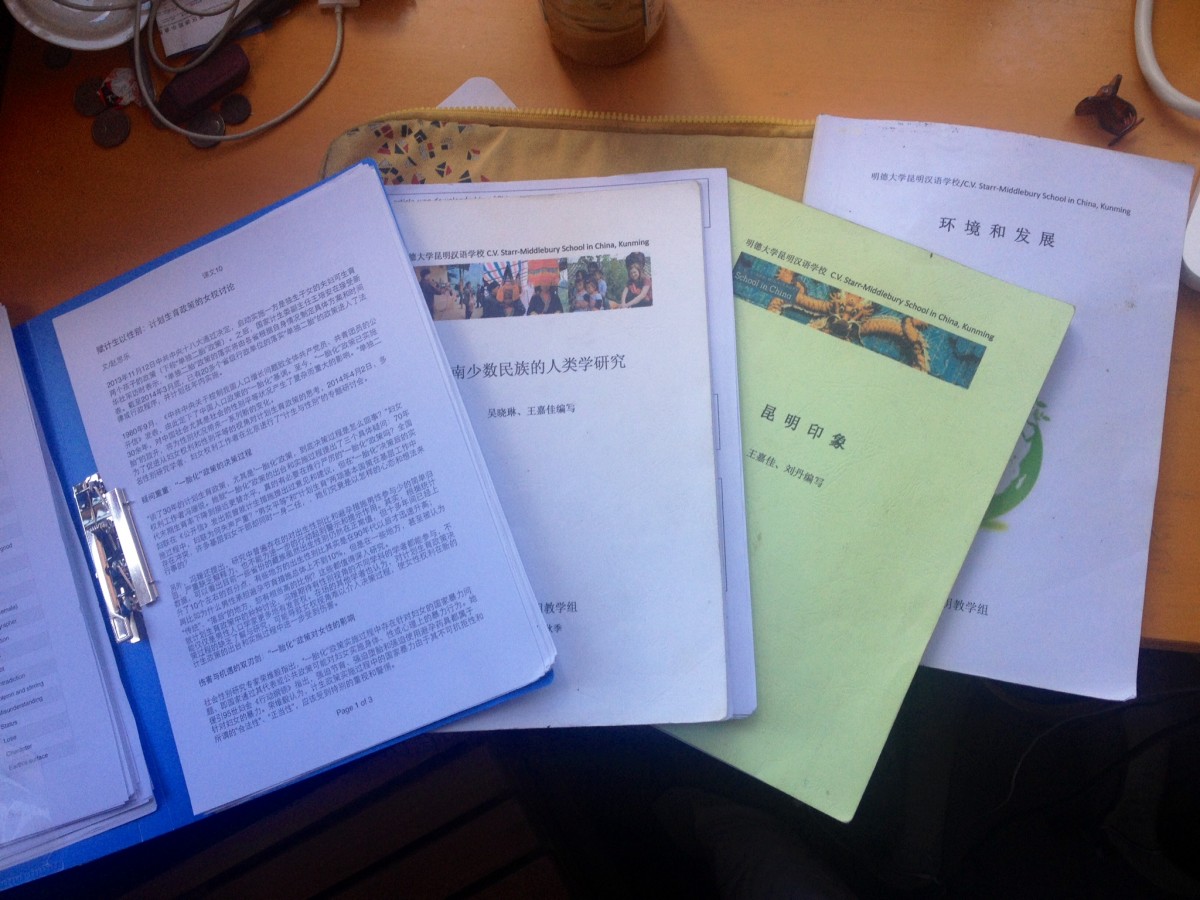Browsing through Pomona’s newly released Spring 2015 course schedule, I couldn’t help but think about just how different my classes here in Kunming are from classes at home. The most obvious difference is that all of my classes are conducted in Chinese. Adhering to the language pledge, we speak no English at all. Another major difference is size. While my classes at Pomona can be considered small, my classes here all have only 1-6 students — tiny. Formal descriptions of all the classes offered by Middlebury in Kunming can be found here. Below is a list of the four classes I am currently taking and my own descriptions.

1. Kunming Impressions
This is a required course for all 16 students in the program. We’re split into 4 classes of 4 students each and interestingly, classmates and teachers rotate weekly. Kunming Impressions is a language-based class, meaning it’s taught by Chinese language teachers and we focus on learning vocabulary and grammar patterns. The content is a survey of topics relating to the city of Kunming and Yunnan Province — education, migrant workers, political figures, NGOs, and so on. We regularly conduct interviews with locals, which can be intimidating, but also very informative. Though Kunming Impressions is a language class, I appreciate that it incorporates a relevant and interesting topic — the city of Kunming.
2. Yunnan’s Ethnic Minorities: Anthropological Perspectives
Yunnan Province is well-known for its large, diverse population of ethnic minorities. I figured I couldn’t come to Yunnan and not learn about its rich ethnic cultures and practices. This class has 6 students and is taught by a professor from Yunnan Nationalities University. It is a content-based course taught in Chinese, meaning that we focus on discussion and really understanding the course content . So it’s like a regular college seminar class, but conducted entirely in Chinese. We’ve talked about religions, bilingual education, family structure, and more. I really enjoy this class; not only is the content fascinating, but I’m able to practice expressing opinions and complex thoughts in Chinese during class discussions. We also conduct interviews and go on field trips. Tomorrow, we’ll be going on a field trip to a Miao Christian village a few hours outside of Kunming.
3. China’s Environment and Development
Along with China’s recent rapid economic development, all kinds of environmental problems have emerged. I chose this class because I think conflict between economic development and environmental protection is one of China’s most interesting and pressing current issues, and I wanted to gain a deeper understanding of it. This class has only 2 students (one other student and myself) and is taught by 2 teachers — one Chinese language teacher and one Ph.D candidate in Environmental Studies. It’s another content-based class, though we also learn lots of new vocabulary and grammar patterns. Our class topics have included recycling, plastic bag bans, food safety, biodiversity and deterioration of ecological systems, implementation of current laws and regulations, and more. We recently conducted a food safety investigation and I believe we have a field trip coming up soon.
4. One-on-One Tutorial – Feminism in China

I think this is one of the coolest opportunities we have on this program — each student gets to choose a topic that we’d like to study in-depth, and we’re paired with an instructor, usually a graduate student, in that subject. We meet as often as our regular classes to discuss readings, and of course, everything is in Chinese. My one-on-one topic is feminism and women’s roles in Chinese society. My instructor is a graduate student in philosophy who considers himself a feminist. I like the fact that he has a background in philosophy, as we often discuss feminist and social issues from a philosophical angle. Some topics we’ve covered are women’s roles throughout Chinese history, female factory workers, portrayals of women in movies, the one-child policy and reproductive rights, and sex work. My instructor is pretty involved in the Chinese feminist movement, which opens up a lot of opportunities. For example, last night I was able to attend a lecture on the current Chinese feminist movement by a couple well-known Chinese feminists. I also plan to visit a migrant worker NGO that my instructor regularly volunteers at. Though I sometimes think I could learn faster and more in-depth in English, it really makes a lot of sense to learn about feminism in China in Chinese. Now that we’re in the second part of the semester, I’m preparing to write a research paper about gender-based violence in China.
